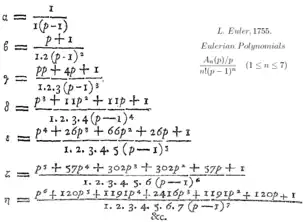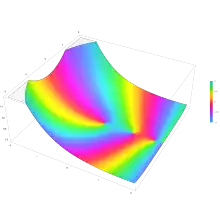Eulerian number
In combinatorics, the Eulerian number is the number of permutations of the numbers 1 to in which exactly elements are greater than the previous element (permutations with "ascents").
Leonhard Euler investigated them and associated polynomials in his 1755 book Institutiones calculi differentialis.

Other notations for are and .
Definition
The Eulerian polynomials are defined by the exponential generating function
The Eulerian numbers may be defined as the coefficients of the Eulerian polynomials:
An explicit formula for is[1]
 A plot of the Eulerian numbers with the second argument fixed to 5.
A plot of the Eulerian numbers with the second argument fixed to 5.
Basic properties
- For fixed there is a single permutation which has 0 ascents: . Indeed, as for all , . This formally includes the empty collection of numbers, . And so .
- For the explicit formula implies , a sequence in that reads .
- Fully reversing a permutation with ascents creates another permutation in which there are ascents. Therefore . So there is also a single permutation which has ascents, namely the rising permutation . So also equals .
- A lavish upper bound is . Between the bounds just discussed, the value exceeds .
- For , the values are formally zero, meaning many sums over can be written with an upper index only up to . It also means that the polynomials are really of degree for .
A tabulation of the numbers in a triangular array is called the Euler triangle or Euler's triangle. It shares some common characteristics with Pascal's triangle. Values of (sequence A008292 in the OEIS) for are:
- kn
0 1 2 3 4 5 6 7 8 0 1 1 1 2 1 1 3 1 4 1 4 1 11 11 1 5 1 26 66 26 1 6 1 57 302 302 57 1 7 1 120 1191 2416 1191 120 1 8 1 247 4293 15619 15619 4293 247 1 9 1 502 14608 88234 156190 88234 14608 502 1
Computation
For larger values of , can also be calculated using the recursive formula
This formula can be motivated from the combinatorial definition and thus serves as a natural starting point for the theory.
For small values of and , the values of can be calculated by hand. For example
n k Permutations A(n, k) 1 0 (1) A(1,0) = 1 2 0 (2, 1) A(2,0) = 1 1 (1, 2) A(2,1) = 1 3 0 (3, 2, 1) A(3,0) = 1 1 (1, 3, 2), (2, 1, 3), (2, 3, 1) and (3, 1, 2) A(3,1) = 4 2 (1, 2, 3) A(3,2) = 1
Applying the recurrence to one example, we may find
Likewise, the Eulerian polynomials can be computed by the recurrence
The second formula can be cast into an inductive form,
The following is a python implementation.
import math # python 3.8
def Ank(n, k) -> int:
"""
Compute A(n, k) using the explicit formula.
"""
def summand(i):
return (-1) ** i * math.comb(n + 1, i) * (k + 1 - i) ** n
return sum(map(summand, range(k + 1)))
def Anks(n) -> list:
"""
Coefficient list for the n'th polynomial A_n(t).
"""
return [1] if n == 0 else [Ank(n, k) for k in range(n)]
def eval_polynomial(coeffs, t):
"""
Polynomial evaluation function.
"""
return sum(c * t ** k for k, c in enumerate(coeffs))
def An(n, t: float) -> float:
"""
Polynomial A_n(t).
"""
return eval_polynomial(Anks(n), t)
# Print the first few polynomials
sup = lambda n: str(n).translate(str.maketrans("0123456789", "⁰¹²³⁴⁵⁶⁷⁸⁹"))
sub = lambda n: str(n).translate(str.maketrans("0123456789", "₀₁₂₃₄₅₆₇₈₉"))
NUM = 8
for n in range(NUM):
print(f"A{sub(n)}(t) = " + " + ".join(f"{ank} t{sup(k)}" for k, ank in enumerate(Anks(n))))
# E.g. A₇(t) = 1 t⁰ + 120 t¹ + 1191 t² + 2416 t³ + 1191 t⁴ + 120 t⁵ + 1 t⁶
# Sanity checks
assert Ank(n, 1) == 2 ** n - (n + 1)
assert n == 0 or An(n, 1) == math.factorial(n) # Cardinality check
alternating_sum: float = sum((-1)**k * Ank(n, k) / math.comb(n - 1, k) for k in range(n))
assert n < 2 or abs(alternating_sum) < 1e-13
Identities
For any property partitioning a finite set into finitely many smaller sets, the sum of the cardinalities of the smaller sets equals the cardinality of the bigger set. The Eulerian numbers partition the permutations of elements, so their sum equals the factorial . I.e.
as well as . To avoid conflict with the empty sum convention, it is convenient to simply state the theorems for only.
Much more generally, for a fixed function integrable on the interval [2]
Worpitzky's identity[3] expresses as the linear combination of Eulerian numbers with binomial coefficients:
From it, it follows that
Formulas involving alternating sums
The alternating sum of the Eulerian numbers for a fixed value of is related to the Bernoulli number
Furthermore,
and
Formulas involving the polynomials
The symmetry property implies:
The Eulerian numbers are involved in the generating function for the sequence of nth powers:
An explicit expression for Eulerian polynomials is [4]
Where is the Stirling numbers of the second kind.
Eulerian numbers of the second order
The permutations of the multiset which have the property that for each k, all the numbers appearing between the two occurrences of k in the permutation are greater than k are counted by the double factorial number . The Eulerian number of the second order, denoted , counts the number of all such permutations that have exactly m ascents. For instance, for n = 3 there are 15 such permutations, 1 with no ascents, 8 with a single ascent, and 6 with two ascents:
- 332211,
- 221133, 221331, 223311, 233211, 113322, 133221, 331122, 331221,
- 112233, 122133, 112332, 123321, 133122, 122331.
The Eulerian numbers of the second order satisfy the recurrence relation, that follows directly from the above definition:
with initial condition for n = 0, expressed in Iverson bracket notation:
Correspondingly, the Eulerian polynomial of second order, here denoted Pn (no standard notation exists for them) are
and the above recurrence relations are translated into a recurrence relation for the sequence Pn(x):
with initial condition . The latter recurrence may be written in a somewhat more compact form by means of an integrating factor:
so that the rational function
satisfies a simple autonomous recurrence:
Whence one obtains the Eulerian polynomials of second order as , and the Eulerian numbers of second order as their coefficients.
The following table displays the first few second-order Eulerian numbers:
- kn
0 1 2 3 4 5 6 7 8 0 1 1 1 2 1 2 3 1 8 6 4 1 22 58 24 5 1 52 328 444 120 6 1 114 1452 4400 3708 720 7 1 240 5610 32120 58140 33984 5040 8 1 494 19950 195800 644020 785304 341136 40320 9 1 1004 67260 1062500 5765500 12440064 11026296 3733920 362880
The sum of the n-th row, which is also the value , is .
Indexing the second-order Eulerian numbers comes in three flavors:
References
- Eulerus, Leonardus [Leonhard Euler] (1755). Institutiones calculi differentialis cum eius usu in analysi finitorum ac doctrina serierum [Foundations of differential calculus, with applications to finite analysis and series]. Academia imperialis scientiarum Petropolitana; Berolini: Officina Michaelis.
- Carlitz, L. (1959). "Eulerian Numbers and polynomials". Math. Mag. 32 (5): 247–260. doi:10.2307/3029225. JSTOR 3029225.
- Gould, H. W. (1978). "Evaluation of sums of convolved powers using Stirling and Eulerian Numbers". Fib. Quart. 16 (6): 488–497.
- Desarmenien, Jacques; Foata, Dominique (1992). "The signed Eulerian numbers". Discrete Math. 99 (1–3): 49–58. doi:10.1016/0012-365X(92)90364-L.
- Lesieur, Leonce; Nicolas, Jean-Louis (1992). "On the Eulerian Numbers M=max (A(n,k))". Europ. J. Combinat. 13 (5): 379–399. doi:10.1016/S0195-6698(05)80018-6.
- Butzer, P. L.; Hauss, M. (1993). "Eulerian numbers with fractional order parameters". Aequationes Mathematicae. 46 (1–2): 119–142. doi:10.1007/bf01834003. S2CID 121868847.
- Koutras, M.V. (1994). "Eulerian numbers associated with sequences of polynomials". Fib. Quart. 32 (1): 44.
- Graham; Knuth; Patashnik (1994). Concrete Mathematics: A Foundation for Computer Science (2nd ed.). Addison-Wesley. pp. 267–272.
- Hsu, Leetsch C.; Jau-Shyong Shiue, Peter (1999). "On certain summation problems and generalizations of Eulerian polynomials and numbers". Discrete Math. 204 (1–3): 237–247. doi:10.1016/S0012-365X(98)00379-3.
- Boyadzhiev, Khristo N. (2007). "Apostol-Bernoulli functions, derivative polynomials and Eulerian polynomials". arXiv:0710.1124 [math.CA].
- Petersen, T. Kyle (2015). Eulerian Numbers. Birkhäuser Advanced Texts Basler Lehrbücher. Birkhäuser. pp. 3–18. doi:10.1007/978-1-4939-3091-3_1. ISBN 978-1-4939-3090-6.
Citations
- (L. Comtet 1974, p. 243)
- Exercise 6.65 in Concrete Mathematics by Graham, Knuth and Patashnik.
- Worpitzky, J. (1883). "Studien über die Bernoullischen und Eulerschen Zahlen". Journal für die reine und angewandte Mathematik. 94: 203–232.
- Qi, Feng; Guo, Bai-Ni (2017-08-01). "Explicit formulas and recurrence relations for higher order Eulerian polynomials". Indagationes Mathematicae. 28 (4): 884–891. doi:10.1016/j.indag.2017.06.010. ISSN 0019-3577.
External links
- Eulerian Polynomials at OEIS Wiki.
- "Eulerian Numbers". MathPages.com.
- Weisstein, Eric W. "Eulerian Number". MathWorld.
- Weisstein, Eric W. "Euler's Number Triangle". MathWorld.
- Weisstein, Eric W. "Worpitzky's Identity". MathWorld.
- Weisstein, Eric W. "Second-Order Eulerian Triangle". MathWorld.
- Euler-matrix (generalized rowindexes, divergent summation)